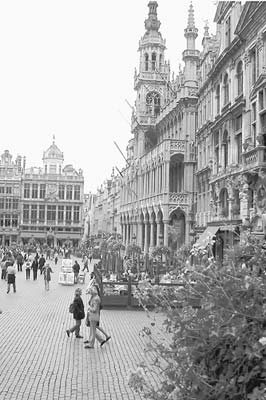
This walk takes in Brussels’ delightful old center, starting at its spectacular main square. After exploring the Grand Place, we’ll loop a couple blocks north, see the Bourse, and then end south of the Grand Place at the Manneken-Pis.
Length of This Walk: Allow two hours.
Brewery Museum: €5, daily 10:00-17:00 except Dec-March Sat-Sun opens at 12:00.
City Museum: €4, Tue-Sun 10:00-17:00, Thu until 20:00, closed Mon.
Chocolate Shops: Generally Mon-Sat 9:00-22:00, Sun 10:00-22:00.
This colorful cobblestone square is the heart—historically and geographically—of heart-shaped Brussels. As the town’s market square for 1,000 years, this was where farmers and merchants sold their wares in open-air stalls, enticing travelers from the main east-west highway across Belgium, which ran a block north of the square. Today, shops and cafés sell chocolates, gaufres (waffles), beer, mussels, fries, dentelles (lace), and flowers.
Brussels was born about 1,000 years ago at a strategic spot on the banks of the Senne (not Seine) River, which today is completely bricked over. The river crossed the main road from Köln to Bruges.
Pan the square to get oriented. Face the Town Hall, with your back to the King’s House. The TI is one block behind you, and “restaurant row” is another block beyond that. To your right, a block away (downhill), catch a glimpse of the Bourse building. The Upper Town is to your left, rising up the hill beyond the Central Station. Over your left shoulder a few blocks away is St. Michael’s Cathedral. And most important? The Manneken-Pis is three blocks ahead, down the street that runs along the left side of the Town Hall.
The Town Hall (Hôtel de Ville) dominates the square with its 300-foot-tall tower, topped by a golden statue of St. Michael slaying a devil (open only by tour). This was where the city council met to rule this free trading town. Brussels proudly maintained its self-governing independence while dukes, kings, and clergymen ruled much of Europe. These days, the Town Hall hosts weddings—Crown Prince Philippe got married here in 1999. (The Belgian government demands that all marriages first be performed in simple civil ceremonies.)

Opposite the Town Hall is the impressive, gray King’s House (Maison du Roi), used by the Habsburg kings not as a house, but as an administrative center. Rebuilt in the 1890s, it’s a stately and prickly Neo-Gothic building. Inside is the mildly interesting City Museum (described later).
The fancy smaller buildings giving the square its uniquely grand medieval character are former guild halls (now mostly shops and restaurants), their impressive gabled roofs topped with statues. Once the home offices for the town’s different professions (brewers, bakers, and Manneken-Pis-corkscrew-makers), they all date from shortly after 1695—the year French king Louis XIV’s troops surrounded the city, sighted their cannons on the Town Hall spire, and managed to level everything around it (4,000 mostly wooden buildings) without ever hitting the spire itself. As a matter of pride, these Brussels businessmen rebuilt their offices better than ever, completing everything within seven years. They’re in stone, taller, and with ornamented gables and classical statues. While they were all built at about the same time, the many differences in styles reflect the independent spirit of the people and the many cultural influences that converged in this crossroads trading center.
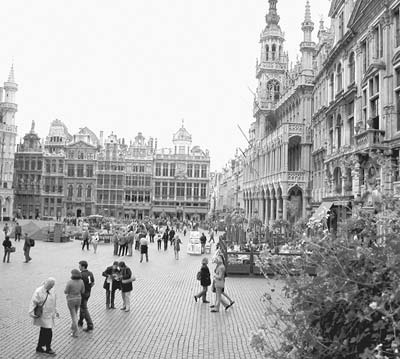
The Swan House (#9, just to the left of the Town Hall—find the plaque) once housed a bar where Karl Marx and Friedrich Engels met in February of 1848 to write their Communist Manifesto, and where the first German Workers’ Association (the proto-communist party) met. Later that year, when their treatise sparked socialist revolution around Europe, Brussels exiled Marx and Engels. Today, the once-proletarian bar is one of the city’s most expensive restaurants. Next door (#10) was and still is the brewers’ guild, now housing the Brewery Museum.
Each rooftop statue comes with its own uninteresting legend, but the Bruxelloise have an earthier explanation: “What’s that smell?” say the statues on the roof of the Swan House. “Someone farted.” “Yeah,” says the golden man riding a horse atop the Brewery Museum next door, “it was that guy over there,” and he points north across the square to another statue. “It wasn’t me,” says that statue, “it was him—way over there.” Follow his gaze to the middle of the northwest side of the square, where the statue of a saint with a shepherd’s staff hangs his head in shame.
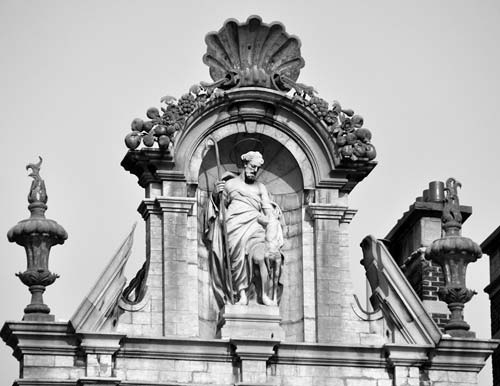
Imagine this already glorious square filled with a carpet of flowers. Every other year (next in August of 2014; www.flowercarpet.be), florists create a colorful 19,000-square-foot pattern of tightly packed begonias—that’s about three-quarters of a million individual flowers. Begun in 1971 by a begonia salesman as a way to promote his wares, this gorgeous display has become a biannual Brussels fixture that makes this grand space even grander.
• Inside the King’s House (Maison du Roi)—across the Grand Place from the Town Hall—is the only museum of any importance on the square, the...
This museum has three stories of exhibits: The top floor displays a chronological history of the city and an enjoyable room full of costumes dampened by the Manneken-Pis statue; the middle floor has a 20-minute film on city history and maps and models of 13th- and 17th-century Brussels; and the ground floor features tapestries and paintings. Borrow the English descriptions in each room.
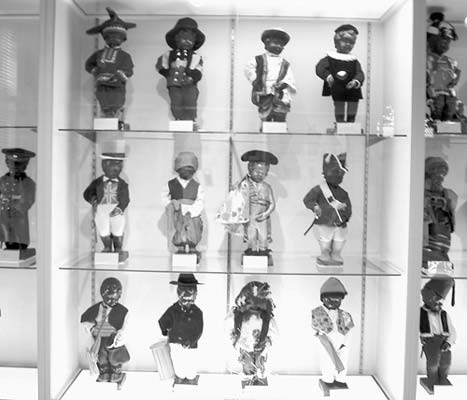
Most visitors aim straight for the Manneken-Pis outfits, upstairs. It’s a longstanding tradition for the statue to be outfitted in clothing—the little guy goes through several costume changes each week. Many of the costumes you’ll see here were donated by other countries—you’ll see everything from a Civil War Union soldier to an El Salvadorian farmer, from a Polish hussar to a Japanese samurai, from an Indian maharajah to a Spanish bullfighter, from a Russian cosmonaut to a Fiji islander...and much more. Once up here, sit down and enjoy the video showing visitors’ reactions to the ridiculous little statue.
On the middle floor, be sure to find the model of the city in the 13th century. (To follow the directions in this description, uphill is east.) The largest structure is St. Michael’s Cathedral (northeast). The Upper Town hasn’t a hint of its monumental future. The Grand Place’s embryonic beginning is roughly in the center of town, amid a cluster of houses.
The city was a port town—see the crane unloading barges—since it was at this point that the shallow Senne became navigable. Grain from the area was processed in the watermills, then shipped downstream to Antwerp and on to the North Sea.
By the 1200s, Brussels—though tiny by today’s standards—was an important commercial center, and St. Michael’s was the region’s religious hub. Still, most of the area inside the 2.5-mile-long city wall was farmland, dotted with a few churches, towers, markets, and convents (such as the Carmelite convent hugging the south wall).
The model in the far end of the room shows the city a couple centuries later—much bigger, but still within the same wall. By this time, the Upper and Lower Towns are clearly defined. In the Upper Town, the huge palace of the dukes of Burgundy marks the site of today’s Royal Palace.
On the ground floor you’ll see the original statues that once adorned the Town Hall. The limestone is no match for the corrosive acidic air, so they were brought inside for protection. Also on this floor are a few old paintings, fine carved altarpieces, tapestries, sculpture, and porcelain.
Cafés: Mussels in Brussels, Belgian-style french fries, yeasty local beers, waffles...if all you do here is plop down at a café on the square, try some of these specialties, and watch the world go by—hey, that’s a great afternoon in Brussels.
The outdoor cafés are casual and come with fair prices (a good Belgian beer costs €4.50—with no cover or service charge). Have a seat, and a waiter will serve you. The half-dozen or so cafés on the downhill side of the square are all roughly equal in price and quality for simple drinks and foods—check the posted menus. As they are generally owned by breweries, you won’t have a big selection of beers.
Choco-Crawl: The best chocolate shops all lie along the north (uphill) side of the square, starting with Godiva at the high end (higher in both altitude and price). The cost goes down slightly as you descend to the other shops. Each shop has a mouth-watering display case of 20 or so chocolates and sells mixes of 100 grams—your choice of 8 pieces—for about €5, or individual pieces for about €1. Americans use the word “chocolates” indiscriminately to describe the different varieties you’d find in a box of chocolates, but the Belgians call them either “truffles” (soft, crumbly chocolate shells filled with buttercream) or “pralines” (made of a hard chocolate shell with a wide range of fillings—uniquely Belgian and totally different from the sugar-and-nuts French praline). Chocolate shops are generally open Monday to Saturday from 9:00 to 22:00 and Sunday from 10:00 to 22:00.
Godiva, with the top reputation internationally, is synonymous with fine Belgian chocolate. Now owned by a Turkish company, Godiva still has its management and the original factory (built in 1926) in Belgium. This store, at Grand Place 22, was Godiva’s first (est. 1937). The almond and honey goes way beyond almond roca.
Neuhaus, a few doors down at #27, has been encouraging local chocoholics since 1857. Their main store is in the Galeries St. Hubert (described later). Neuhaus publishes a good little pamphlet explaining its products. The “caprice” (toffee with vanilla crème) tastes like Easter. Neuhaus claims to be the inventor of the praline.
Galler, just off the square at Rue au Beurre 44, is homier and less famous because it doesn’t export. Still family-run (and the royal favorite), it proudly serves less sugary chocolate—dark. The new top-end choice, 85 percent pure chocolate, is called simply “Black 85”—and worth a sample if you like chocolate without the sweetness. Galler’s products are well-described in English.
Leonidas, four doors down at Rue au Beurre 34, is where cost-conscious Bruxelloise get their fix, sacrificing 10 percent in quality to nearly triple their take (machine-made, only €2.20/100 grams). White chocolate is their specialty.
If all the chocolate has made you thirsty, wash it down with 250 Beers, next to Leonidas.
• Exit the Grand Place next to Godiva (from the northeast, or uphill, corner of the square), and go north one block on Rue de la Colline (passing a popular Tintin shop at #9) to Rue du Marché-aux-Herbes/Grasmarkt, which was once the main east-west highway through Belgium. The little park-like square just to your right—a modest gathering place with market stalls—is nicknamed “Agora” (after the marketplaces of ancient Greece).
Looking to the right, notice that it’s all uphill from here to the Upper Town, another four blocks (and 200-foot elevation gain) beyond. Straight ahead, you enter the arcaded shopping mall called...
Built in 1847, Europe’s oldest still-operating shopping mall served as the glass-covered model that inspired many other shopping galleries in Paris, London, and beyond. It celebrated the town’s new modern attitude (having recently gained its independence from the Netherlands). Built in an age of expansion and industrialization, the mall demonstrated efficient modern living, with elegant apartments upstairs above trendy shops, theaters, and cafés. Originally, you had to pay to get in to see its fancy shops, and that elite sensibility survives today. Even today, people live in the upstairs apartments.

Looking down the arcade, you’ll notice that it bends halfway down, designed to lure shoppers farther. Its iron-and-glass look is still popular, but the decorative columns, cameos, and pastel colors evoke a more elegant time. It’s Neo-Renaissance, like a pastel Florentine palace.
There’s no Gap (yet), no Foot Locker, no Karmelkorn. Instead, you’ll find hat, cane, and, umbrella stores that sell...hats, canes, and umbrellas—that’s it, all made on the premises. Philippe (halfway down the first section, on the left), carries shoes made especially for the curves of your feet, handcrafted by a family that’s been doing it for generations. Since 1857, Neuhaus (near the end of the first section, on the right) has sold chocolates from here at its flagship store, where many Brussels natives buy their pralines—invented in this very house in 1912. Across from Neuhaus, the Taverne du Passage restaurant serves the same local specialties that singer Jacques Brel used to come here for: croquettes de crevettes (shrimp croquettes), tête de veau (calf’s head), anguilles au vert (eels with herb sauce), and fondue au fromage (cheese fondue; €15-25 meals, daily 12:00-24:00).
• Midway down the mall, where the two sections bend, turn left and exit the mall onto...
Yikes! During meal times, this street is absolutely crawling with tourists browsing through wall-to-wall, midlevel-quality restaurants. Brussels is known worldwide for its food, serving all kinds of cuisine, but specializing in seafood (particularly mussels). You’ll have plenty to choose from along this table-clogged “restaurant row.” To get an idea of prices, compare their posted menùs—the fixed-price, several-course meal offered by most restaurants. But don’t count on getting a good value—better restaurants are just a few steps away.
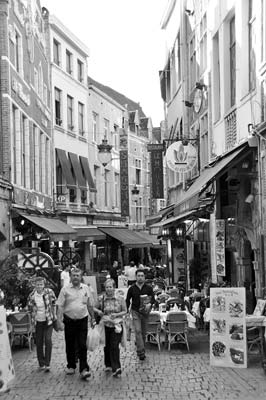
Many diners here are day-trippers. Colin from London, Marie from Paris, Martje from Holland, and Dietrich from Frankfurt could easily all “do lunch” together in Brussels—just three hours away.
The first intersection, with Petite Rue des Bouchers, is the heart of the restaurant quarter, which sprawls for several blocks around. The street names reveal what sorts of shops used to stand here—butchers (bouchers), herbs, chickens, and cheese.
• At this intersection, turn left onto Petite Rue des Bouchers and walk straight back to the Grand Place. (You’ll see the Town Hall tower ahead.) At the Grand Place, turn right (west) on Rue du Beurre. Comparison-shop a little more at the Galler and Leonidas chocolate stores and pass by the little “Is it raining?” fountain. At the intersection with Rue du Midi is the...
Since the 12th century, there’s been a church here. Inside, along the left aisle, see rough stones in some of the arches from the early church. Outside, notice the barnacle-like shops, such as De Witte Jewelers, built right into the church. The church was rebuilt 300 years ago with money provided by the town’s jewelers. As thanks, they were given these shops with apartments upstairs. Close to God, this was prime real estate. And jewelers are still here.
• Just beyond the church, you run into the back entrance of a big Neoclassical building.
The stock exchange was built in the 1870s in the Historicist style—a mix-and-match, Neo-everything architectural movement. Plans are in the works for the former stock exchange to host a big beer museum. The ruins under glass on the right side of the Bourse are from a 13th-century convent; there’s a small museum inside.
Several historic cafés huddle around the Bourse. To the right (next to the covered ruins) is the woody Le Cirio, with its delightful circa-1900 interior. Around the left side of the Bourse is the Falstaff Café, which is worth a peek inside. Some Brussels cafés, like the Falstaff, are still decorated in the early 20th-century style called Art Nouveau. Ironwork columns twist and bend like flower stems, and lots of Tiffany-style stained glass and mirrors make them light and spacious. Slender, elegant, willowy Gibson Girls decorate the wallpaper, while waiters in bowties glide by.
• Circle around to the front of the Bourse, toward the busy Boulevard Anspach.
Brussels is the political nerve center of Europe (with as many lobbyists as Washington, DC), and the city sees several hundred demonstrations a year. When the local team wins a soccer match or some political group wants to make a statement, this is where people flock to wave flags and honk horns.

It’s also where the old town meets the new. To the right along Boulevard Anspach are two shopping malls and several first-run movie theaters. Rue Neuve, which parallels Anspach, is a bustling pedestrian-only shopping street.
Boulevard Anspach covers the still-flowing Senne River (which was open until 1870). Remember that Brussels was once a port, with North Sea boats coming as far as this point to unload their goods. But with frequent cholera epidemics killing thousands of its citizens, the city decided to cover up its stinky river.
Beyond Boulevard Anspach—two blocks past the black, blocky skyscraper—is the charming Ste. Catherine neighborhood, clustered around the former fish market and the Church of Ste. Catherine. This village-like zone is the easiest escape from the bustle of downtown Brussels, and features two ideal lunch stops: the Mer du Nord/Nordzee fish bar and the delightful Belgian cheese shop Cremerie de Linkebeek (both worth a detour).
• For efficient sightseeing, consider catching a taxi across the street from the Bourse to the Place Royale, where you can follow my Upper Town Walk (see next chapter), also ending at the Manneken-Pis. But if you’d rather stay in the Lower Town, return to the Grand Place.
• Leave the square kitty-corner, heading south down the street running along the left side of the Town Hall, Rue Charles Buls (which soon changes its name to Stoofstraat). Just five yards off the square, under the arch, are two interesting monuments honoring illustrious Brussels mayors:
The first monument features a beautiful young man—an Art Nouveau allegory of knowledge and science (which brings illumination, as indicated by the Roman oil lamp)—designed by Victor Horta. It honors Charles Buls, mayor from 1888 to 1899. If you enjoyed the Grand Place, thank him for saving it. He stopped King Leopold II from blasting a grand esplanade from Grand Place up the hill to the palace.
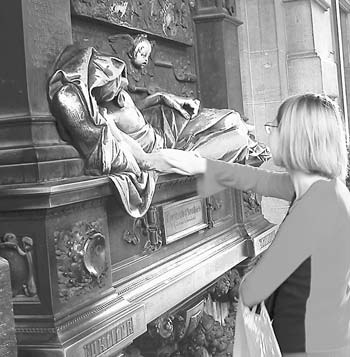
A few steps farther you’ll see tourists and locals rubbing a brass statue of a reclining man. This was Mayor Evrard ’t Serclaes, who in 1356 bravely refused to surrender the keys of the city to invaders, and so was tortured and killed. Touch him, and his misfortune becomes your good luck. Judging by the reverence with which locals treat this ritual, I figure there must be something to it.
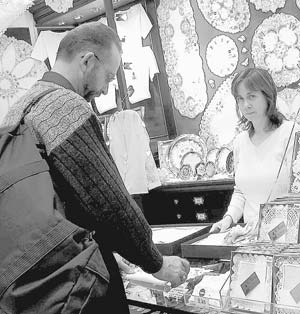
A half-block farther (on the left), the N. Toebac Lace Shop shows off some fine lace. Brussels is perhaps the best-known city for traditional lacemaking, and this shop still sells handmade pieces in the old style: lace clothing, doilies, tablecloths, and ornamental pieces. The shop gives travelers with this book a 15 percent discount. For more on lace, the Costume and Lace Museum is a block away and just around the corner (closed Wed).
A block farther down the street on the left (at the little yellow window before the busy street) is the always-popular Waffle Factory, where €2 gets you a freshly made take-away “Belgian” (Liège-style) waffle (up to €7 more if you opt for any of the fun toppings).
Across the busy street, step into the Textilux Center (Rue Lombard 41, on the left) for a good look at Belgian tapestries—both traditional wall-hangings and modern goods, such as tapestry purses and luggage in traditional designs.
High on the wall to the right, notice the delightful comic strip panel depicting that favorite of Belgian comic heroes, Tintin, climbing a fire escape. (For those unfamiliar with this character—beloved by virtually all Europeans—his dog is named Snowy, Captain Haddock keeps an eye out for him, and the trio are always getting into misadventures.) Dozens of these building-sized comic-strip panels decorate Brussels (marked on the TI’s €0.50 map), celebrating the Belgians’ favorite medium. Just as Ireland has its writers, Italy its painters, and France its chefs, Belgium has a knack for turning out world-class comic artists.
• Follow the crowds, noticing the excitement build, because in another block you reach the...
Even with low expectations, this bronze statue is smaller than you’d think—the little squirt’s under two feet tall, practically the size of a newborn. Still, the little peeing boy is an appropriately low-key symbol for the unpretentious Bruxelloise. The statue was made in 1619 to provide drinking water for the neighborhood. Notice that the baby, sculpted in Renaissance style, actually has the musculature of a man instead of the pudgy limbs of a child. The statue was knighted by the occupying King Louis XV—so French soldiers had to salute the eternally pissing lad when they passed.

As it’s tradition for visiting VIPs to bring the statue an outfit, and he also dresses up for special occasions, you can often see the Manneken peeing through a colorful costume. A sign on the fence lists the month’s festival days and how he’ll be dressed. For example, on January 8, Elvis Presley’s birthday, he’s an Elvis impersonator; on Prostate Awareness Day, his flow is down to a slow drip. He can also be hooked up to a keg to pee wine or beer.
There are several different legends about the story behind Manneken—take your pick: He was a naughty boy who peed inside a witch’s house, so she froze him. A rich man lost his son and declared, “Find my son, and we’ll make a statue of him doing what he did when found.” Or—the locals’ favorite version—the little tyke loved his beer, which came in handy when a fire threatened the wooden city: He bravely put it out. Want the truth? The city commissioned the Manneken to show the freedom and joie de vivre of living in Brussels—where happy people eat, drink...and drink...and then pee.

The gathering crowds make the scene more interesting. Hang out for a while and watch the commotion this little guy makes as tour groups come and go. When I was there, a Russian man marveled at the statue, shook his head, and said, “He never stop!”